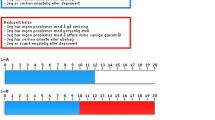Abstract
The time trade-off method was incorporated into a study of valuation of health states following treatment for breast cancer. A major aim of the work was to determine whether different groups give different valuations. The time trade-off technique was simple and quick to administer, acceptable to subjects, and produced different values in different groups. Age and sex of valuers had some influence: the most striking differences were found between women who had experlenced breast cancer and those who had not. The time trade-off method has considerable potential in health state valuation. The choice of valuers needs to be further explored.
Similar content being viewed by others
References
Williams A. Health economics: the cheerful face of a dismal science? In: Williams A, ed. Health and Economics. London: Macmillan, 1987: 1–11.
Torrance GW. Measurement of health state utilities for economic appraisal: a review. J Health Econ 1986; 5: 1–30.
Williams A. The value of QALYs. Health Soc Serv J 1985; 18(suppl. 8): 3–5.
Williams A. Economics of coronary artery bypass grafting. Br Med J 1985; 291: 326–329.
Rosser RM, Kind P. A scale of valuation of states of illness: is there a social consensus? Int J Epidemiol 1978; 7: 347–358.
Kind P, Rosser R, Williams A. Valuation of quality of life: some psychometric evidence. In: Jones-Less MW, ed. The Value of Life and Safety North Holland Publishing Co, 1982: 159–170.
Drummond MD, Stoddart G, Torrance GW. Methods for the Economic Evaluation of Health Care Programmes, Oxford: OUP, 1987.
Williams A. Methodologic Issues in Quality of Life Measurement for Health or Health Care. York: University of York: mimeo, 1987.
Sackett DL, Torrance GW. The utility of different health states as perceived by the general public. J Chronic Dis 1978; 31: 697–704.
Nelson EC, Wasson J, Kirk A et al. Functional health status levels of primary care patients. J Am Med Assoc 1983; 249: 3331–3338.
Cadman D, Goldsmith C, Bashim P. Values, preferences and decisions in the care of children with developmental disabilities. Dev Behav Paediatr 1984; 5: 60–64.
Craig TJ, Comstock GW, Geiser PB. The quality of survival in breast cancer—a case control comparison. Cancer 1974; 33: 1451–1457.
Greer S, Morris T, Pettingale KW. Psychological response to breast cancer: effect on outcome. Lancet 1979; ii: 785–787.
Maguire GP, Lee EG, Bevington DJ, Küchemann CS, Crabtree RJ, Cornell CE. Psychiatric problems in the first year after mastectomy. Br Med J 1978; 1: 963–965.
Meyerowitz BE, Sparks FC, Spears IK. Adjuvant chemotherapy for breast cancer. Cancer 1983; 43: 1613–1618.
Morris T, Greer HS, White P. Psychological and social adjustment to mastectomy. Cancer 1977; 40: 2381–2387.
Van Dam FSA, Linssen ACG, Engelsman E, Van Bentham J, Hanewald GJFP. Life with cytostatic drugs. In: Breast Cancer: Experimental and Clinical Aspects, Proceedings of the second EORTC Breast Cancer Working Conference, 229–233.
Winick L, Robbins CF. Physical and psychological readjustment after mastectomy. Cancer 1977; 39: 478–486.
Mohide EA, Torrance GW, Streiner DL, Pringle DM, Gibert R. Measuring the well-being of family caregivers using the time trade-off technique. J Clin Epidemiol 1988; 41: 475–482.
Hershy JE et al. Sources of bias in assessment procedures for utility functions. Management Science 1982; 28(8): 936–954.
Buxton MJ, Ashby J. The time trade-off approach to health state valuation. In: Teeling-Smith G, ed. Measuring Health: A Practical Approach. London: John Wiley, 1988: 69–87.
Author information
Authors and Affiliations
Additional information
This work was completed by Joy Ashby shortly before her tragic death in 1989. Incorporating the study design of the immediately preceding project, ‘Alternative Methods of Valuing Health States’ (Buxton, Ashby and O'Hanlon, 1987), valuations of breast cancer states were obtained from a group of breast cancer patients. It was decided, that despite the time lapse since the study was conducted, that this material is a valuable addition to the existing body of knowledge surrounding health state valuations.
Funded by the Office of Health Economics, London.
Rights and permissions
About this article
Cite this article
Ashby, J., O'Hanlon, M. & Buxton, M.J. The time trade-off technique: how do the valuations of breast cancer patients compare to those of other groups?. Qual Life Res 3, 257–265 (1994). https://doi.org/10.1007/BF00434899
Received:
Accepted:
Issue Date:
DOI: https://doi.org/10.1007/BF00434899




